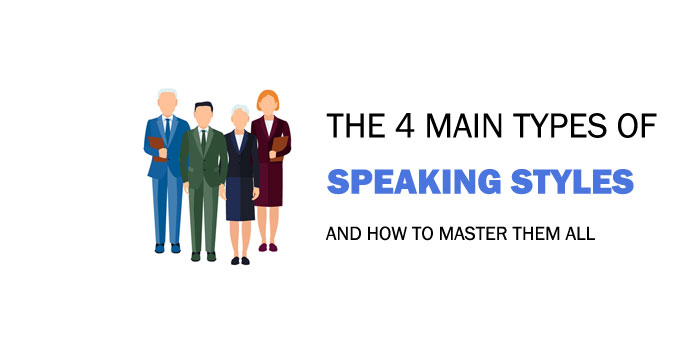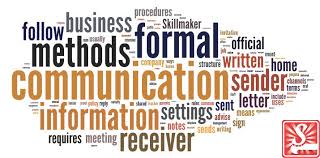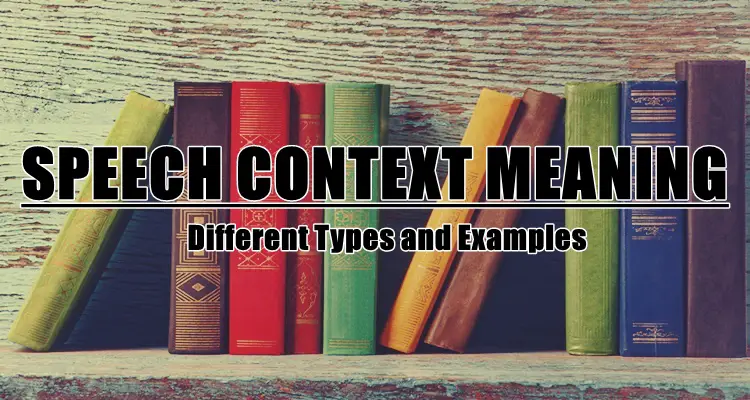
Ace the Presentation


The 5 Different Types of Speech Styles
Human beings have different ways of communicating . No two people speak the same (and nor should they). In fact, if you’ve paid any attention to people’s speeches around you, you might have already noticed that they vary from speaker to speaker, according to the context. Those variations aren’t merely coincidental.
The 5 Different Types of Speech Styles (Table)
Martin Joos, a famous german linguist and professor, was the first one to organize the speeches according to their variations, having come up with five speech styles, depending on their degree of formality:
1. Frozen Style (or Fixed speech)
A speech style is characterized by the use of certain grammar and vocabulary particular to a certain field, one in which the speaker is inserted. The language in this speech style is very formal and static, making it one of the highest forms of speech styles. It’s usually done in a format where the speaker talks and the audience listens without actually being given the space to respond.
Application: It’s generally reserved for formal settings such as important ceremonies (for instance, a ceremony at the royal palace or one in which a country’s president is present), weddings, funerals, etc.
Examples: a presidential speech, an anthem, and a school creed.
2. Formal Style
This style, just like the previous one, is also characterized by a formal (agreed upon and even documented) vocabulary and choice of words, yet it’s more universal as it doesn’t necessarily require expertise in any field and it’s not as rigid as the frozen style.
The language in this speech is respectful and rejects the use of slang, contractions, ellipses and qualifying modal adverbials. Oftentimes the speaker must plan the sentences before delivering them.
Application: Although it’s often used in writing, it also applies to speaking, especially to medium to large-sized groups. It’s also the type of speech that should be used when communicating with strangers and others such as older people, elders, professionals, and figures of authority.
Examples: meetings (corporate or other formal meetings), court, class, interview, speech, or presentation.

3. Consultative Style
The third level of communication it’s a style characterized by a semi-formal vocabulary, often unplanned and reliant on the listener ’s responses and overall participation.
Application: any type of two-way communication, dialogue, whether between two people or more, where there’s no intimacy or any acquaintanceship.
Examples: group discussions, teacher-student communication, expert-apprentice, communication between work colleagues or even between employer-employee, and talking to a stranger.
4. Casual Style (or Informal Style)
As the name says, this style is characterized by its casualty, with a flexible and informal vocabulary that may include slang. It’s usually unplanned, pretty relaxed, and reliant on the fluid back and forth between those involved, without any particular order.
Application: used between people with a sense of familiarity and a relatively close relationship, whether in a group or in a one-on-one scenario.
Examples: chats with friends and family, casual phone calls, or text messages.
5. Intimate Style
This is the speech style that’s reserved for people who have a really close connection. It’s casual and relaxed and goes beyond words, as it incorporates nonverbal communication and even personal language codes, such as terms of endearment and expressions whose meaning are only understood by the participants, besides slang.
Application: used between people who share an intimate bond.
Examples: chats between best friends, boyfriend and girlfriend, siblings and other family members, whether in messages, phone calls, or personally.
Here are some of our top recommended Articles to Check next!

The 4 Methods or Types of Speech Delivery

What Makes a Great Presenter? 9 Key Qualities to Look for!

An Easy Guide to All 15 Types of Speech
4 factors that influence speech styles.
Although knowing the definition and some examples of situations in which each speech style might apply is helpful, there are four important factors that are key in speech styles. These factors help the speakers understand when it is appropriate to use one style instead of the other. They are:
1. The Setting
The setting is essentially the context in which the speech shall take place. It’s probably the most important factor to be considered when choosing which speech style to use as nothing could be more harmful than applying the wrong speech style to the wrong setting.
Although it’s a factor that’s exhausted and diverse, to make things simple for you, I’ve divided them in three main categories:
- Formal Settings:
- Casual Settings:
In these settings, people are more relaxed and less uptight than in formal settings. Since there’s a degree of familiarity between those speaking, even though people are not necessarily intimate, the speaker can apply either consultative or casual speech styles. Some examples of these settings include weddings, company or team meetings, and school classes.
- Informal Settings:
These settings are more open than casual ones as there are almost no rules to how people should interact. Everyone in it either has a deep degree of familiarity or intimacy. The styles of speeches that are used in these settings are Casual and Intimate. A few examples of these settings are family and friends gatherings, private conversations, etc.
Misreading the setting can be really embarrassing and have devastating consequences. If, for instance, you make inappropriate jokes in a work meeting or use slang words, you could be perceived as unprofessional and disrespectful, and that could cost you your job.
2. The Participants
Your audience, the people to whom your speech is directed, or the people you interact with are decisive factors when choosing your speech style.
To put it simply:
- Reserve Frozen and Formal styles for people whom you respect and are not intimate or even familiar with , either because of their position in society or because of their position in relation to you. These can be authority figures or even superiors in your workplace and strangers.
- Use Consultative and Casual speech styles with people who, even though they are familiar to you (either because you both know each other or interact often), still owe them a certain level of respect . These can be people in your workplace such as your colleagues and business partners, people in school, elders and older family members, neighbors, acquaintances and even strangers .
- Feel free to use Intimate speech styles with anyone who you share an intimate bond with . These can be your friends and your immediate and extended family members .
3. The Topic
Speech styles can give appropriate weight to serious topics, just as they can help alleviate the heaviness of certain topics. There’s no specific rule of which style to use with each topic, actually, when it comes to topics, the choice should be more intuitive and keep in mind the other factors.
For example, sometimes, when making a presentation about a serious topic at a conference, you might want to mix formal speech with a more consultative or casual speech by sliding in a joke or two in between your presentation, as this helps lighten up the mood.
4. The Purpose of The Discourse or Conversation
The purpose of your discourse is your main motivation for speaking. Just like with the topic, when it comes to choosing the speech style taking into account the purpose, the choice is mostly intuitive and keeps in mind the other factors.
You should remember never to mix a business-centered discussion, where the purpose is mostly professional and formal, with a mainly informal speech of speaking.

Speaker Styles
- Content-rich speaker:
A content-rich speaker is one whose aim is to use the speech to inform. He is factual and very objective and focused on providing all the information the audience or receptor of the message needs.
A man speaking in a presentation could be an example of this, or even a lawyer defending a case in court.
- Funny or humorous speakers:
As the name already suggests, this type of speaker uses humor as a tool to help them deliver their message. Even when delivering facts, they make jokes to lighten things up and break the tension.
Stand-up comedians are a great example of this type of speaker.
- Storyteller:
This type of speaker usually relies on the story format to deliver his message; whether it’s factual or not is not relevant as long as the main message behind the story is relevant to the receptor.
Usually, the type of speaker is not fixed in each speech style; one person can be many types of speakers depending on the speech style that they are using and keeping in mind the factors that influence the choice of the speech style.
Make sure you weigh all factors equally before choosing a speech style. You don’t want to be THAT person bringing up an intimate subject to a friend in front of a group of strangers during a business meeting where the subject has nothing to do with whatever you’re talking about.

What’s The Importance of Speech Styles In Communication
Using and knowing speech styles is the key to effective communication. Choosing the right way to communicate in different settings and with different people is what separates a good communicator from a bad communicator.
Knowing the speech styles and the rules that apply to each of them saves you from embarrassment and positions you as someone of principles and respectful, especially in formal and conservative settings.
Besides that, people tend to gravitate more towards and get influenced by good communicators; therefore, learning something new in that area and improving the quality of your speech and presentations will only benefit you.
Further Readings
Speech Styles- ELCOMBLUS
Types of Speech Styles | PDF | Sentence (Linguistics) | Cognitive Science- SCRIBD
Similar Posts

Public Speaking Exercises
Knowing how to communicate correctly is one of the skills that most favors professionals in all areas. Those who speak well can motivate, convince, inspire and influence people. And did you know that there are public speaking exercises capable of making you even better? Oratory helps give speeches, but it also serves to help in…

The 4 Types of Motivational Speeches & When to Use them
Did you ever think about how by just talking with someone, you get some energy, inspiration, or idea that motivates you in a way that you couldn’t have expected? After that talk, you get up and quickly start working on that GOAL that you never did. That is what a motivational speech is all about….

DELIVER AN EFFECTIVE DEBATE AND SPEECH WITH THIS 5-STEP STRATEGY
Delivering a debate and speech is actually different from just writing your debate speech. This is why some people can actually prepare outstanding content for their debate speech and still not ace it, not because there was a lack of quality material but because the debate and speech wasn’t effectively presented. A poorly researched debate…

17 Ways to Help Your Child Develop Public Speaking Skills (Public Speaking Tips for Kids)
Speaking in public can be nerve-wracking for a lot of people, and is one area many people shy away from a lot. But if this important skill can be learned at a very early age, kids stand to gain a lot of benefits from it that can serve them well into adulthood. Therefore, today we…

Body Language and Gestures – 5 Great Tips for More Effective presentations
Introduction to Body Language / Mannerisms/ Gestures Body language in simple terms can be explained as those nonverbal signs we give off in our day-to-day communication with one another. This can range from anything from facial expressions to simple body movements, small but crucial subconscious actions that make up much of our non-verbalized interactions. Language…

8 Tips on How to Overcome the Public Speaking Fear
Public Speaking Fear is quite common. In fact, 3 in every four people are afraid of speaking in public. Regardless of the numbers from researches, this is a prevalent problem, so much so that every one of us might have faced it or seen people who suffer from it. I have got a more in-depth…

Want to create or adapt books like this? Learn more about how Pressbooks supports open publishing practices.
Chapter 1: The Speech Communication Process
The Speech Communication Process
- Listener(s)
Interference
As you might imagine, the speaker is the crucial first element within the speech communication process. Without a speaker, there is no process. The speaker is simply the person who is delivering, or presenting, the speech. A speaker might be someone who is training employees in your workplace. Your professor is another example of a public speaker as s/he gives a lecture. Even a stand-up comedian can be considered a public speaker. After all, each of these people is presenting an oral message to an audience in a public setting. Most speakers, however, would agree that the listener is one of the primary reasons that they speak.
The listener is just as important as the speaker; neither one is effective without the other. The listener is the person or persons who have assembled to hear the oral message. Some texts might even call several listeners an “audience. ” The listener generally forms an opinion as to the effectiveness of the speaker and the validity of the speaker’s message based on what they see and hear during the presentation. The listener’s job sometimes includes critiquing, or evaluating, the speaker’s style and message. You might be asked to critique your classmates as they speak or to complete an evaluation of a public speaker in another setting. That makes the job of the listener extremely important. Providing constructive feedback to speakers often helps the speaker improve her/his speech tremendously.
Another crucial element in the speech process is the message. The message is what the speaker is discussing or the ideas that s/he is presenting to you as s/he covers a particular topic. The important chapter concepts presented by your professor become the message during a lecture. The commands and steps you need to use, the new software at work, are the message of the trainer as s/he presents the information to your department. The message might be lengthy, such as the President’s State of the Union address, or fairly brief, as in a five-minute presentation given in class.
The channel is the means by which the message is sent or transmitted. Different channels are used to deliver the message, depending on the communication type or context. For instance, in mass communication, the channel utilized might be a television or radio broadcast. The use of a cell phone is an example of a channel that you might use to send a friend a message in interpersonal communication. However, the channel typically used within public speaking is the speaker’s voice, or more specifically, the sound waves used to carry the voice to those listening. You could watch a prerecorded speech or one accessible on YouTube, and you might now say the channel is the television or your computer. This is partially true. However, the speech would still have no value if the speaker’s voice was not present, so in reality, the channel is now a combination of the two -the speaker’s voice broadcast through an electronic source.
The context is a bit more complicated than the other elements we have discussed so far. The context is more than one specific component. For example, when you give a speech in your classroom, the classroom, or the physical location of your speech, is part of the context . That’s probably the easiest part of context to grasp.
But you should also consider that the people in your audience expect you to behave in a certain manner, depending on the physical location or the occasion of the presentation . If you gave a toast at a wedding, the audience wouldn’t be surprised if you told a funny story about the couple or used informal gestures such as a high-five or a slap on the groom’s back. That would be acceptable within the expectations of your audience, given the occasion. However, what if the reason for your speech was the presentation of a eulogy at a loved one’s funeral? Would the audience still find a high-five or humor as acceptable in that setting? Probably not. So the expectations of your audience must be factored into context as well.
The cultural rules -often unwritten and sometimes never formally communicated to us -are also a part of the context. Depending on your culture, you would probably agree that there are some “rules ” typically adhered to by those attending a funeral. In some cultures, mourners wear dark colors and are somber and quiet. In other cultures, grieving out loud or beating one’s chest to show extreme grief is traditional. Therefore, the rules from our culture -no matter what they are -play a part in the context as well.
Every speaker hopes that her/his speech is clearly understood by the audience. However, there are times when some obstacle gets in the way of the message and interferes with the listener’s ability to hear what’s being said. This is interference , or you might have heard it referred to as “noise. ” Every speaker must prepare and present with the assumption that interference is likely to be present in the speaking environment.
Interference can be mental, physical, or physiological. Mental interference occurs when the listener is not fully focused on what s/he is hearing due to her/his own thoughts. If you’ve ever caught yourself daydreaming in class during a lecture, you’re experiencing mental interference. Your own thoughts are getting in the way of the message.
A second form of interference is physical interference . This is noise in the literal sense -someone coughing behind you during a speech or the sound of a mower outside the classroom window. You may be unable to hear the speaker because of the surrounding environmental noises.
The last form of interference is physiological . This type of interference occurs when your body is responsible for the blocked signals. A deaf person, for example, has the truest form of physiological interference; s/he may have varying degrees of difficulty hearing the message. If you’ve ever been in a room that was too cold or too hot and found yourself not paying attention, you’re experiencing physiological interference. Your bodily discomfort distracts from what is happening around you.
The final component within the speech process is feedback. While some might assume that the speaker is the only one who sends a message during a speech, the reality is that the listeners in the audience are sending a message of their own, called feedback . Often this is how the speaker knows if s/he is sending an effective message. Occasionally the feedback from listeners comes in verbal form – questions from the audience or an angry response from a listener about a key point presented. However, in general, feedback during a presentation is typically non-verbal -a student nodding her/his head in agreement or a confused look from an audience member. An observant speaker will scan the audience for these forms of feedback, but keep in mind that non-verbal feedback is often more difficult to spot and to decipher. For example, is a yawn a sign of boredom, or is it simply a tired audience member?
Generally, all of the above elements are present during a speech. However, you might wonder what the process would look like if we used a diagram to illustrate it. Initially, some students think of public speaking as a linear process -the speaker sending a message to the listener -a simple, straight line. But if you’ll think about the components we’ve just covered, you begin to see that a straight line cannot adequately represent the process, when we add listener feedback into the process. The listener is sending her/his own message back to the speaker, so perhaps the process might better be represented as circular. Add in some interference and place the example in context, and you have a more complete idea of the speech process.
Fundamentals of Public Speaking Copyright © by Lumen Learning is licensed under a Creative Commons Attribution 4.0 International License , except where otherwise noted.
Share This Book
- Delivery Techniques →
The 4 Main Types of Speaking Styles (& How to Master Them All)

Have you ever compared your speaking style with famous presenters like Steve Jobs or Jill Bolte? These people know how to adopt the right speaking style for every occasion.
Speaking style is a collection of characteristics that can relate speech to a particular communication setting. Every word we speak is a form of communication, whether directly or otherwise.
When people speak, their speech goes with a style. Hence, the way one person speaks differs from that of another person.
However, always speaking in a particular style is not required. In fact, that relies on the context, the subject, and the listener.
One time in a workshop, a presenter spoke in a way he felt was effective, but he didn't know it wouldn't work for the students in the class . Before the end of the class, half of the seats were empty, while the rest mumbled.
He learned the right speaking style the hard way, but you don't have to. Thus, gather more experience before accepting an invitation as a speaker or venturing fully into your public speaking career .

The 4 Main Types of Speaking Styles
There is an unlimited speaking style for every occasion. For example, the way you speak at a wedding is different from the way you will speak in the church.
Although you can use different styles on one occasion, it is still advisable to use various speaking styles.
One of the most exciting parts of public speaking is watching other people. As you watch others speak, you will understand that you can effectively communicate a message in various ways.
As previously stated, to discover your unique style of speaking, you must first determine which style speaks to you.
We've broken down the most basic types of speaking styles below to enable you to read through and decide which style is ideal for you.
1. The Motivational Style
A motivational speaker exhibits a variety of characteristics. It all swings to the following three things: tone, speed, and energy . A speaker who has perfected these elements is more likely to be a successful motivational speaker.
Any competent motivating speaker can energize the crowd. The goal is to inspire and captivate the listeners.

These three elements are explained below.
Tone: A motivational speech cannot be delivered in a flat tone. You must add a sense of mystery and drama through voice diversity.
Nothing is more annoying than a boring motivational speaker. Always remember to put your stamp on whatever you say and represent.
Pace: Your tempo influences how enthusiastic your audience will be. Speaking quickly frequently increases the enthusiasm of the audience.
However, you must be cautious not to overuse this technique . It may become tiresome if you continuously talk fast, and the listener will not keep up.
Energy: Another of the most important aspects of motivational speaking is energy. You wish to be upbeat and optimistic in your speech.
If you deliver an energy-filled performance or speech, your audience will remember you and become more eager to hear more of what you have to say.
2. The Command Style: Speak Firmly and Respectfully
You may occasionally need to convey your message with seriousness; thus, how you do so must be appropriate.
You should be able to persuade your listeners of the importance of what you have to say. People respect you more when you can control a room effectively.

You might also like: How to Speak with Conviction
Speaking about important matters is more suitable with the command style. This can include speaking in the presence of significant individuals or on touchy subjects. Exercising vocal control should be done correctly.
A powerful speech may be delivered effectively by speaking more slowly and with a lower tone. Making deliberate, smooth movements also enhances the whole experience.
Keep in mind that you must not stick to one style throughout your presentation.
While it is necessary to make this the dominating emotion of your speech, you can switch to motivating or some other style of speaking to make the style and pace different enough to engage your audience .
3. The Facilitating Style: Shake It Up
The motivational speaking and the facilitating speaking style are quite similar. What is the major distinction? Getting the crowd into action.
This style of speaking engages the audience completely. It might be difficult, though, because you must be quite knowledgeable about your subject matter. You never know what someone could ask when you open the floor.
The facilitator spends more time listening than speaking. They spend time crafting their messages and occasionally forget that communication requires reciprocity.

People have the chance to work with you on the collaborative exchange of ideas in the facilitator style. It involves speaking softly, using softer moves, and expressing warmth with your facial expressions and voice.
The most crucial thing to remember is that your daily speech patterns are just habits. Your options are not fully open. You have a lot to give people, so be sure to broaden your horizons, find your style, and be open to changing your speaking style to best suit your audience, including your message.
4. The Entertaining Style
An entertaining speaker wins over the audience—the ideal decision is to break up the usual melancholy and repetitive delivery.

A more energetic personality is best suited for this style. You must relax and take control of your surroundings. Similar to how this kind of speaker moves, they usually have a more approachable tone.
They exude a sense of comfort, which will, in turn, enables the listeners to feel at ease. The presentation exudes a lighthearted air that makes everyone more relaxed.
The assumption is that all you need to do to be successful is to be funny . This frequently results in speakers cramming jokes in their speeches, which takes attention away from their primary point and may come out as forced. You can watch these positive body gestures to improve your speech.
Conclusion: Mastering the Speaking Styles
You should be able to see that there's something distinctive to contribute to the audience after looking through these many speaking styles.
Many renowned speakers dominate the market, yet none of these people has the qualities that you do.
Therefore, find the mix or style that suits you the best. Farther than that, practice is the key to fluency. The first approach to honing your skill is to become aware of your speaking style.
Best wishes to you.

Want to create or adapt books like this? Learn more about how Pressbooks supports open publishing practices.
14.2 Speaking Contexts That Affect Delivery
Learning objectives.
- Understand how the physical setting of a speech is an element that calls for preparation.
- Examine some tips and strategies for common speaking situations.

Mad Mou – Empty – CC BY-NC-ND 2.0.
The Reverend Dr. Martin Luther King Jr. gave his famous “I Have a Dream” speech on the steps of the Lincoln Memorial at a gigantic civil rights rally on an August afternoon in 1963. His lectern was bristling with microphones placed there for news coverage and for recording the historic event. His audience, estimated to number a quarter of a million people, extended as far as the eye could see. He was the last speaker of the day, delivering his speech after more than a dozen civil rights leaders and world-famous performers such as Joan Baez, Mahalia Jackson, and Charlton Heston had occupied the stage (Ross, 2007). King gave us his speech in the assertive ringing tones of inspired vision. Nothing less would have worked that day.
Most of us will never speak to so many people at once. Even an appearance on television will probably command a much smaller audience than the crowd that heard King’s speech. Even though you don’t expect an audience of such size or a setting of such symbolic importance, you should still be prepared to adapt to the setting in which you will speak.
Our audiences, circumstances, and physical contexts for public speaking will vary. At some point in your life you may run for public office or rise to a leadership role in a business or volunteer organization. Or you may be responsible for informing coworkers about a new policy, regulation, or opportunity. You may be asked to deliver remarks in the context of a worship service, wedding, or funeral. You may be asked to introduce a keynote speaker or simply to make an important announcement in some context. Sometimes you will speak in a familiar environment, while at other times you may be faced with an unfamiliar location and very little time to get used to speaking with a microphone. These are contexts and situations we address in the following subsections.
Using Lecterns
A lectern is a small raised surface, usually with a slanted top, where a speaker can place notes during a speech. While a lectern adds a measure of formality to the speaking situation, it allows speakers the freedom to do two things: to come out from behind the lectern to establish more immediate contact with the audience and to use both hands for gestures.
However, for new speakers who feel anxious, it is all too tempting to grip the edges of the lectern with both hands for security. You might even wish you could hide behind it. Be aware of these temptations so you can manage them effectively and present yourself to your audience in a manner they will perceive as confident. One way to achieve this is by limiting your use of the lectern to simply a place to rest your notes. Try stepping to the side or front of the lectern when speaking with free hands, only occasionally standing at the lectern to consult your notes. This will enhance your eye contact as well as free up your hands for gesturing.
Speaking in a Small or Large Physical Space
If you are accustomed to being in a classroom of a certain size, you will need to make adjustments when speaking in a smaller or larger space than what you are used to.
A large auditorium can be intimidating, especially for speakers who feel shy and “exposed” when facing an audience. However, the maxim that “proper preparation prevents poor performance” is just as true here as anywhere. If you have prepared and practiced well, you can approach a large-venue speaking engagement with confidence. In terms of practical adjustments, be aware that your voice is likely to echo, so you will want to speak more slowly than usual and make use of pauses to mark the ends of phrases and sentences. Similarly, your facial expressions and gestures should be larger so that they are visible from farther away. If you are using visual aids, they need to be large enough to be visible from the back of the auditorium.
Limited space is not as disconcerting for most speakers as enormous space, but it has the advantage of minimizing the tendency to pace back and forth while you speak. We have all seen dramatic soliloquies in the movies and plays where an actor makes use of the space on the stage, but this is generally not a good strategy for a speech. A small space also calls for more careful management of notecards and visual aids, as your audience will be able to see up close what you are doing with your hands. Do your best to minimize fumbling, including setting up in advance or arriving early to decide how to organize your materials in the physical space. We will discuss visual aids further in Chapter 15 “Presentation Aids: Design and Usage” .
Speaking Outdoors
Outdoor settings can be charming, but they are prone to distractions. If you’re giving a speech in a setting that is picturesquely beautiful, it may be difficult to maintain the audience’s attention. If you know this ahead of time, you might plan your speech to focus more on mood than information and perhaps to make reference to the lovely view.
More typically, outdoor speech venues can pose challenges with weather, sun glare, and uninvited guests, such as ants and pigeons. If the venue is located near a busy highway, it might be difficult to make yourself heard over the ambient noise. You might lack the usual accommodations, such as a lectern or table. Whatever the situation, you will need to use your best efforts to project your voice clearly without sounding like you’re yelling.
Using a Microphone
Most people today are familiar with microphones that are built into video recorders and other electronic devices, but they may be new at using a microphone to deliver a speech. One overall principle to remember is that a microphone only amplifies, it does not clarify. If you are not enunciating clearly, the microphone will merely enable your audience to hear amplified mumbling.
Microphones come in a wide range of styles and sizes. Generally, the easiest microphone to use is the clip-on style worn on the front of your shirt. If you look closely at many television personalities and news anchors, you will notice these tiny microphones clipped to their clothing. They require very little adaptation. You simply have to avoid looking down—at your notes, for instance—because your voice will be amplified when you do so.
Lectern and handheld microphones require more adaptation. If they’re too close to your mouth, they can screech. If they’re too far away, they might not pick up your voice. Some microphones are directional, meaning that they are only effective when you speak directly into them. If there is any opportunity to do so, ask for tips about how to use a particular microphone and practice with it for a few minutes while you have someone listen from a middle row in the audience and signal whether you can be heard well. The best plan, of course, would be to have access to the microphone for practice ahead of the speaking date.
Often a microphone is provided when it isn’t necessary. If the room is small or the audience is close to you, do not feel obligated to use the microphone. Sometimes an amplified voice can feel less natural and less compelling than a direct voice. However, if you forgo the microphone, make sure to speak loudly enough for all audience members to hear you—not just those in front.
Audience Size
A small audience is an opportunity for a more intimate, minimally formal tone. If your audience has only eight to twelve people, you can generate greater audience contact. Make use of all the preparation you have done. You do not have to revamp your speech just because the audience is small. When the presentation is over, there will most likely be opportunities to answer questions and have individual contact with your listeners.
Your classroom audience may be as many as twenty to thirty students. The format for an audience of this size is still formal but conversational. Depending on how your instructor structures the class, you may or may not be asked to leave time after your speech for questions and answers.
Some audiences are much larger. If you have an audience that fills an auditorium, or if you have an auditorium with only a few people in it, you still have a clearly formal task, and you should be guided as much as possible by your preparation.
Key Takeaways
- Not every speaking setting happens in a classroom. As such, different environments call for speakers to think through their basic speaking strategies.
- Speakers need to be prepared to deal with five common challenges in speaking contexts: using a lectern, large or small space, speaking in the outdoors, using a microphone, and audience size.
- Get permission from your instructor and announce a campus event to the class. Make sure your details are complete and accurate. How does your physical space affect the way you present the information?
- Watch a speech that takes place indoors or outside. How do you think this speech would be different if the speech occurred in the other location? What changes would you recommend for the speaker?
- If you were suddenly asked to give your next classroom speech in front of two hundred of your peers, how would adjust your speech? Why?
Ross, S. (2007). Civil rights march on Washington. Infoplease . Retrieved from http://www.infoplease.com/spot/marchonwashington.html
Stand up, Speak out Copyright © 2016 by University of Minnesota is licensed under a Creative Commons Attribution-NonCommercial-ShareAlike 4.0 International License , except where otherwise noted.
Share This Book
Introduction to Communication
Communication in context, learning objective.
By the end of this section, you will be able to:
- Identify and describe five types of communication contexts.
Now that we have examined the eight components of communication, let’s examine this in context. Is a quiet dinner conversation with someone you care about the same experience as a discussion in class or giving a speech? Is sending a text message to a friend the same experience as writing a professional project proposal or a purchase order? Each context has an influence on the communication process. Contexts can overlap, creating an even more dynamic process. You have been communicating in many of these contexts across your lifetime, and you’ll be able to apply what you’ve learned through experience in each context to business communication.
Intrapersonal Communication
Have you ever listened to a speech or lecture and gotten caught up in your thoughts so that, while the speaker continued, you were no longer listening? During a phone conversation, have you ever been thinking about what you are going to say, or what question you might ask, instead of listening to the other person? Finally, have you ever told yourself how you did after you wrote a document or gave a presentation? As you “talk with yourself” you are engaged in intrapersonal communication.
Intrapersonal communication involves one person; it is often called “self-talk” (Wood, 1997). Donna Vocate’s book(1994) on intrapersonal communication explains how, as we use language to reflect on our own experiences, we talk ourselves through situations. For example, the voice within you that tells you, “Keep on Going! I can DO IT!” when you are putting your all into completing a five-mile race; or that says, “This report I’ve written is pretty good.” Your intrapersonal communication can be positive or negative, and directly influences how you perceive and react to situations and communication with others.

For example, you may have certain expectations of time and punctuality. You weren’t born with them, so where did you learn them? From those around you as you grew up. What was normal for them became normal for you, but not everyone’s idea of normal is the same.
When your supervisor invites you to a meeting and says it will start at 7 p.m., does that mean 7:00 sharp, 7-ish, or even 7:30? In the business context, when a meeting is supposed to start at 9 a.m., is it promptly a 9 a.m.? Variations in time expectations depend on regional and national culture as well as individual corporate cultures. In some companies, everyone may be expected to arrive ten to fifteen minutes before the announced start time to take their seats and be ready to commence business at 9:00 sharp. In other companies, “meeting and greeting” from about 9 to 9:05 or even 9:10 is the norm. When you are unfamiliar with the expectations for a business event, it is always wise to err on the side of being punctual, regardless of what your internal assumptions about time and punctuality may be.
Interpersonal Communication
The second major context within the field of communication is interpersonal communication. Interpersonal communication normally involves two people, and can range from intimate and very personal to formal and impersonal. You may carry on a conversation with a loved one, sharing a serious concern. Later, at work, you may have a brief conversation about plans for the weekend with the security guard on your way home. What’s the difference? Both scenarios involve interpersonal communication, but are different in levels of intimacy. The first example implies a trusting relationship established over time between two caring individuals. The second example level implies some previous familiarity, and is really more about acknowledging each other than any actual exchange of information, much like saying hello or goodbye.
Group Communication
Have you ever noticed how a small group of people in class sit near each other? Perhaps they are members of the same sports program, or just friends, but no doubt they often engage in group communication.
“ Group communication is a dynamic process where a small number of people engage in a conversation” ( McLean, 2005, p. 14). Group communication is generally defined as involving three to eight people. The larger the group, the more likely it is to break down into smaller groups.
To take a page from marketing, does your audience have segments or any points of convergence/divergence? We could consider factors like age, education, sex, and location to learn more about groups and their general preferences as well as dislikes. You may find several groups within the larger audience, such as specific areas of education, and use this knowledge to increase your effectiveness as a business communicator.
Public Communication
In public communication , one person speaks to a group of people; the same is true of public written communication, where one person writes a message to be read by a small or large group. The speaker or writer may ask questions, and engage the audience in a discussion (in writing, examples are an e-mail discussion or a point-counter-point series of letters to the editor), but the dynamics of the conversation are distinct from group communication, where different rules apply. In a public speaking situation, the group normally defers to the speaker. For example, the boss speaks to everyone, and the sales team quietly listens without interruption.
This generalization is changing as norms and expectations change, and many cultures have a tradition of “call outs” or interjections that are not to be interpreted as interruptions or competition for the floor, but instead as affirmations. The boss may say, as part of a charged-up motivational speech, “Do you hear me?” and the sales team is expected to call back “Yes Sir!” The boss, as a public speaker, recognizes that intrapersonal communication (thoughts of the individual members) or interpersonal communication (communication between team members) may interfere with this classic public speaking dynamic of all to one, or the audience devoting all its attention to the speaker, and incorporate attention getting and engagement strategies to keep the sales team focused on the message.
Mass Communication
How do you tell everyone on campus where and when all the classes are held? Would a speech from the front steps work? Perhaps it might meet the need if your school is a very small one. A written schedule that lists all classes would be a better alternative. How do you let everyone know there is a sale on in your store, or that your new product will meet their needs, or that your position on a political issue is the same as your constituents? You send a message to as many people as you can through mass communication. Does everyone receive mass communication the same way the might receive a personal phone call? Not likely. Some people who receive mass mailings assume that they are “junk mail” (i.e., that they do not meet the recipients’ needs) and throw them away unopened. People may tune out a television advertisement with a click of the mute button, delete tweets or ignore friend requests on Facebook by the hundreds, or send all unsolicited e-mail straight to the spam folder unread.
Mass media is a powerful force in modern society and our daily lives, and is adapting rapidly to new technologies. Mass communication involves sending a single message to a group. It allows us to communicate our message to a large number of people, but we are limited in our ability to tailor our message to specific audiences, groups, or individuals. As a business communicator, you can use multimedia as a visual aid or reference common programs, films, or other images that your audience finds familiar yet engaging. You can tweet a picture that is worth far more than 140 characters, and you are just as likely to elicit a significant response. By choosing messages or references that many audience members will recognize or can identify with, you can develop common ground and increase the appeal of your message.
Key Takeaway
Communication contexts include intrapersonal, interpersonal, group, public, and mass communication. Each context has its advantages and disadvantages, and its appropriate and inappropriate uses.
THINK ABOUT IT
- Image of watch. Authored by : Rcastillon. Provided by : MorgueFile. Located at : http://mrg.bz/pv3gAC . License : All Rights Reserved . License Terms : Free to remix, commercial use, no attribution required. http://www.morguefile.com/license/morguefile
- Communication for Business Success. Authored by : Anonymous. Provided by : Anonymous. Located at : http://2012books.lardbucket.org/books/communication-for-business-success/ . License : CC BY-NC-SA: Attribution-NonCommercial-ShareAlike

Privacy Policy
Home » Topics » Lessons Explained » Oral Communication in Context | Types of Speech Styles
Oral Communication in Context | Types of Speech Styles
- Author Posts

Who among you here finds it hard to understand speech styles? If you are still confuse about this topic in Oral Communication in context, you are in the right page. Today, I’m going to focus in explaining speech styles with various examples real life conversation. I hope you’ll take note some important details that you will learn from here. Let’s get started.
Context is one of the natures of communication. The environment or the situation where communication occurs has direct relation to speech styles. There are actually five speech styles. We have intimate, casual, consultative, formal and frozen.
1.Intimate – This style is private, which occurs between or among close family members or intimate individuals. The language used in this style may no be shared or public.
Example: Proposing your love to your long time partner
2. Casual – This style is common among peers and friends. Jargon, slang, street language, gay language or vulgar words are used in this style. This what you usually use in your daily conversations.
Example: Talking about NBA finals with your friends
3. Consultative – This style is the standard one. Professional or mutually acceptable language is a must in this style. Most of the time one person is superior here.
Example : Students asking her teachers about the requirements in the recent project.
4. Formal – This style is used in formal settings. Unlike the consultative style, this is one way. Think of all the formal events that you have attended. All of those require formal conversation.
Example : Reading news reports, delivering a speech
5. Frozen – This style is “frozen” in time and remains unchanged. It mostly occurs in ceremonies.
Example : Reading pledge of allegiance to the flag
These are the speech styles that we have. We cannot say that we are only limited to one style for we have different contexts of conversation in our daily living.
I hope you learned something from this post. Thank you so much for reading. Feel free to ask questions here.
Please log in or register to reply to this learning.
Join our growing community for FREE!
Only fill in if you are not human
Related Post

ORAL COMMUNICATION IN CONTEXT
Senior high school, types of speech styles.
- FROZEN STYLE
Used generally in very formal setting. Most formal communicative style for respectful situation Does not require any feedback from the audience Usually uses long sentences with good grammar and vocabulary The use of language is fixed and relatively static
Examples: national pledge, anthem, school creeds, marriage ceremonies, speech for a state ceremony
- FORMAL STYLE

Used in speaking to medium to large groups May also be used in single hearers- strangers, older persons, professional Speaker must frame whole sentences ahead before they are delivered Avoids using slang terminologies language is comparatively rigid and has a set, agreed upon vocabulary that is well documented; is often of a standard variety.
Examples: meetings, speeches, school lessons, court, a corporate meeting, at a swearing in ceremony, in an interview or in a classroom

Examples: regular conversation at schools, companies, group discussion, teacher-student, doctor-patient, expert-apprentice

casual conversations with friends, family members, chats, phone calls and messages
5. INTIMATE STYLE
Completely private language used within family of very close friends or group Uses personal language codes Grammar is unnecessary Does not need complete language Certain terms of endearment, slangs or expressions whose meaning is shared with a small subset of persons to person
Share this:
Leave a comment cancel reply.

- Already have a WordPress.com account? Log in now.
- Subscribe Subscribed
- Copy shortlink
- Report this content
- View post in Reader
- Manage subscriptions
- Collapse this bar

- #WalangPasok
- Breaking News
- Photography
- ALS Exam Results
- Aeronautical Engineering Board Exam Result
- Agricultural and Biosystem Engineering Board Exam Result
- Agriculturist Board Exam Result
- Architecture Exam Results
- BAR Exam Results
- CPA Exam Results
- Certified Plant Mechanic Exam Result
- Chemical Engineering Exam Results
- Chemical Technician Exam Result
- Chemist Licensure Exam Result
- Civil Engineering Exam Results
- Civil Service Exam Results
- Criminology Exam Results
- Customs Broker Exam Result
- Dental Hygienist Board Exam Result
- Dental Technologist Board Exam Result
- Dentist Licensure Exam Result
- ECE Exam Results
- ECT Board Exam Result
- Environmental Planner Exam Result
- Featured Exam Results
- Fisheries Professional Exam Result
- Geodetic Engineering Board Exam Result
- Guidance Counselor Board Exam Result
- Interior Design Board Exam Result
- LET Exam Results
- Landscape Architect Board Exam Result
- Librarian Exam Result
- Master Plumber Exam Result
- Mechanical Engineering Exam Results
- MedTech Exam Results
- Metallurgical Engineering Board Exam Result
- Midwives Board Exam Result
- Mining Engineering Board Exam Result
- NAPOLCOM Exam Results
- Naval Architect and Marine Engineer Board Exam Result
- Nursing Exam Results
- Nutritionist Dietitian Board Exam Result
- Occupational Therapist Board Exam Result
- Ocular Pharmacologist Exam Result
- Optometrist Board Exam Result
- Pharmacist Licensure Exam Result
- Physical Therapist Board Exam
- Physician Exam Results
- Principal Exam Results
- Professional Forester Exam Result
- Psychologist Board Exam Result
- Psychometrician Board Exam Result
- REE Board Exam Result
- RME Board Exam Result
- Radiologic Technology Board Exam Result
- Real Estate Appraiser Exam Result
- Real Estate Broker Exam Result
- Real Estate Consultant Exam Result
- Respiratory Therapist Board Exam Result
- Sanitary Engineering Board Exam Result
- Social Worker Exam Result
- UPCAT Exam Results
- Upcoming Exam Result
- Veterinarian Licensure Exam Result
- X-Ray Technologist Exam Result
- Programming
- Smartphones
- Web Hosting
- Social Media
- SWERTRES RESULT
- EZ2 RESULT TODAY
- STL RESULT TODAY
- 6/58 LOTTO RESULT
- 6/55 LOTTO RESULT
- 6/49 LOTTO RESULT
- 6/45 LOTTO RESULT
- 6/42 LOTTO RESULT
- 6-Digit Lotto Result
- 4-Digit Lotto Result
- 3D RESULT TODAY
- 2D Lotto Result
- English to Tagalog
- English-Tagalog Translate
- Maikling Kwento
- EUR to PHP Today
- Pounds to Peso
- Binibining Pilipinas
- Miss Universe
- Family (Pamilya)
- Life (Buhay)
- Love (Pag-ibig)
- School (Eskwela)
- Work (Trabaho)
- Pinoy Jokes
- Tagalog Jokes
- Referral Letters
- Student Letters
- Employee Letters
- Business Letters
- Pag-IBIG Fund
- Home Credit Cash Loan
- Pick Up Lines Tagalog
- Pork Dishes
- Lotto Result Today
- Viral Videos
Speech Context Meaning, Different Types, and Examples
What is speech context meaning and its different types..
SPEECH CONTEXT MEANING – Defining speech context and determining the different types of speech context with examples.
Communication does not only happens between two people. It can be between a person and a group or two groups of people exchanging ideas and thoughts. And speech context is about where the communication happens and how is the message relayed in the whole communication process.

Here are the types of speech context:
- Intrapersonal The communication that happens within oneself. This appears that the source and the receiver of the message is the speaker himself. Often times, this is done when a person does self-reflection and analyzing his own feelings and thoughts. This is also one way in assessing yourself. Example: When choosing what course in college you would want to take. Before coming up with a decision, you’d have to assess your interests, talents, strengths, and weaknesses.
- Interpersonal The communication happens between two or more persons. Depending on the relationship of these people, the communication can be formal, casual, informal, or intimate. 2 types of interpersonal communication: – dyad communication that happens between two people. Example: You and your doctor during consultation. – small group where three or more people are involved but not over 12. Example: You and your groupmates in research sharing ideas.
- Public Communication This happens when a person delivers a message or talks in front of bigger number of people or listeners. Example: A politician presenting his platforms in a grand rally.
- Mass Communication This happens when television, social media, newspaper, magazines, and the likes were used as channels to relay the message. Example: A weatherman discussing the path of the strong typhoon in television.
- Who Am I As Person – A Sample Essay Of “Who Am I As A Person”
- Lie Versus Lay – Grammar Rules and Proper Uses Of “Lie” and “Lay”
What can you say about this? Let us know!
For more news and updates, follow us on Twitter: @ philnews_ph Facebook: @PhilNews and; YouTube channel Philnews Ph .
Leave a Comment Cancel reply

IMAGES
VIDEO
COMMENTS
What is a speech context? What are the different kinds of a speech context? What is a speech style? How can we determine the speech style to be used?Credits:...
The 5 Different Types of Speech Styles (Table) Types of Speech Styles. Description. Application. Example. Frozen/Fixed Style. -Formal rigid and static language, reliant on expertise;-Particular vocabulary, previously agreed upon, that rejects slang. -Formal settings and important ceremonies.-Speaker to an audience without response.
Context. The context is a bit more complicated than the other elements we have discussed so far. The context is more than one specific component. For example, when you give a speech in your classroom, the classroom, or the physical location of your speech, is part of the context . That's probably the easiest part of context to grasp.
Words are chosen for clarity and precision. The intention of the direct-style speaker is to convey as clearly and logically the main idea of the speech, without "beating about the bush." In such a style, non-verbal cues are not as important as the verbal message. Speakers from low-context cultures most often use this communication style.
Thus, gather more experience before accepting an invitation as a speaker or venturing fully into your public speaking career. Table of Contents. The 4 Main Types of Speaking Styles. 1. The Motivational Style. 2. The Command Style: Speak Firmly and Respectfully. 3. The Facilitating Style: Shake It Up.
Dyadic Communication. Dyadic Communication involves only two participants forming the DYAD. One Speaker and one Listener come together to exchange thoughts, ideas, opinions, ' and information. The roles of Speaker and Listener are not fixed, they are interchangeable. Conversation is informal dyadic communication, while interview and dialogue ...
Using Lecterns. A lectern is a small raised surface, usually with a slanted top, where a speaker can place notes during a speech. While a lectern adds a measure of formality to the speaking situation, it allows speakers the freedom to do two things: to come out from behind the lectern to establish more immediate contact with the audience and to use both hands for gestures.
Public Communication. In public communication, one person speaks to a group of people; the same is true of public written communication, where one person writes a message to be read by a small or large group.The speaker or writer may ask questions, and engage the audience in a discussion (in writing, examples are an e-mail discussion or a point-counter-point series of letters to the editor ...
Context is one of the natures of communication. The environment or the situation where communication occurs has direct relation to speech styles. There are actually five speech styles. We have intimate, casual, consultative, formal and frozen. 1.Intimate - This style is private, which occurs between or among close family members or intimate ...
Each speech style intimate, frozen, consultative, casual, or formal or the way language is used, will greatly depend on the speakers' relationship, purpose of the conversation and the speech context dyad, small group, public, and mass communication which, in turn, will also determine what type of utterance or speech act will be used.
Welcome to the Oral Communication in Context Alternative Delivery Mode (ADM) Module on Understanding Speech Context, Speech Style, Speech Act and Communicative Strategy! The hand is one of the most symbolized parts of the human body. It is often used to depict skill, action and purpose. Through our hands, we may learn, create and accomplish.
1. distinguish the types of speeches according to purpose and delivery; 2. determine the types of speeches used in different real-life situations; 3. distinguish the types of speech style; 4. identify the social situations in which each speech style is appropriate to use; and 5. observe the appropriate language forms in using a particular ...
A speech context refers to the environment in which communication occurs. While the focus of studies in the field of communication remained largely on public communication in the past, the discipline has developed interest in studying the various types of communication or speech contexts. Each of the following communication contexts has its own unique characteristics, […]
v 18 I. esson ighlights peech contets may be formal or informal personal or impersonal depending on the relationship of the communicators and the contet The speech style that a communicator adopts depends on the listener the situation and arious factors II. upplementary Information
meetings, speeches, school lessons, court, a corporate meeting, at a swearing in ceremony, in an interview or in a classroom. 3. CONSULTATIVE STYLE. Used in semi-formal communication. Happens in two-way participation. Most operational among other styles. Speaker does not usually plan what he wants to say.
functions of communication. it refers to how humans use language for different purposes. Regulations and control. a communication to influence the behaviour of others. social interactions. use of communication to form and develop relationships. Motivation. use to express wants, needs, desires, and sentiments. information.
This document discusses types of speech contexts and styles. It identifies four main contexts: intrapersonal communication within oneself, interpersonal communication between two or small groups of people, public speaking to larger audiences, and mass communication through media. It also outlines five speech styles - intimate, casual, consultative, formal, and frozen - and provides examples of ...
Types of Speech Context and Style ..... 29 2. Types of Speech Act..... 41 3. Types of Communicative Strategy ..... 49 Unit III. Fundamentals of Public Speaking 1. Principles of Speech Writing ..... 60 2. Principles of Speech Delivery..... 77 Unit IV. Types of Speech 1
2 types of interpersonal communication: - dyad communication that happens between two people. Example: You and your doctor during consultation. - small group where three or more people are involved but not over 12. Example: You and your groupmates in research sharing ideas. Public Communication.
Type of Speech Context and Style - Free download as Powerpoint Presentation (.ppt / .pptx), PDF File (.pdf), Text File (.txt) or view presentation slides online. Type of Speech Context and Style Grade 11 Oral Communication